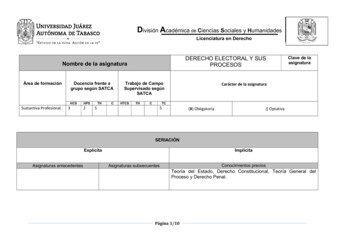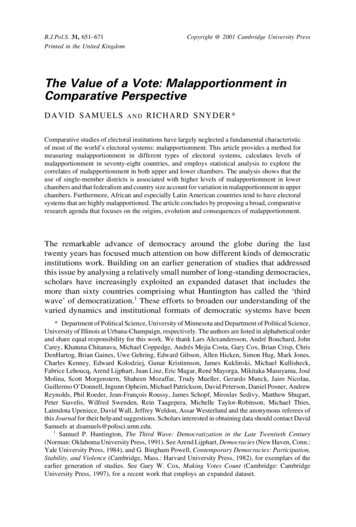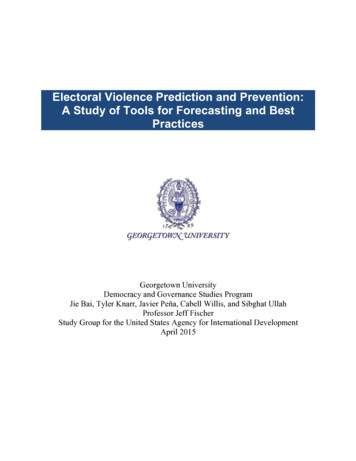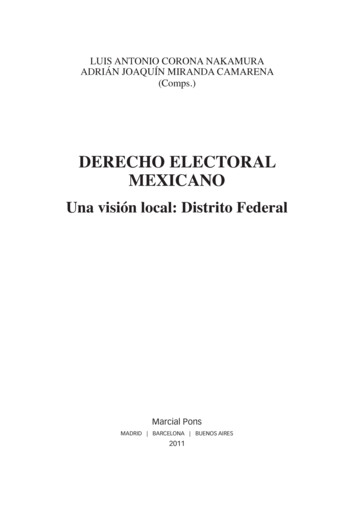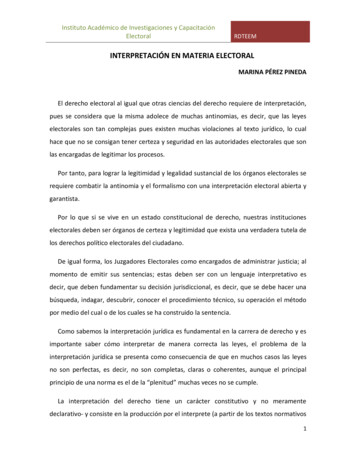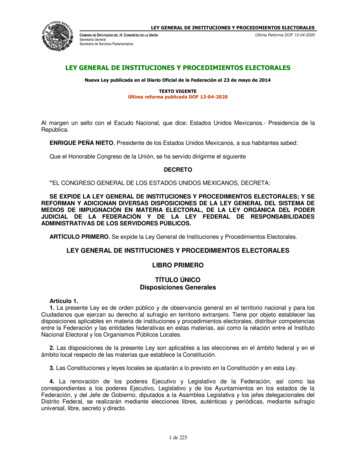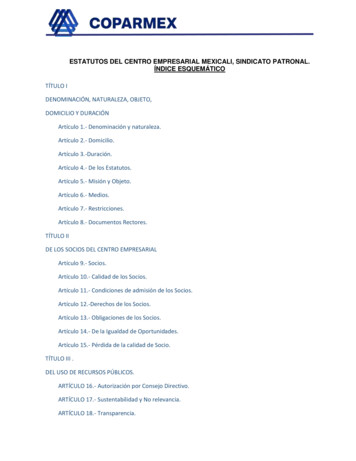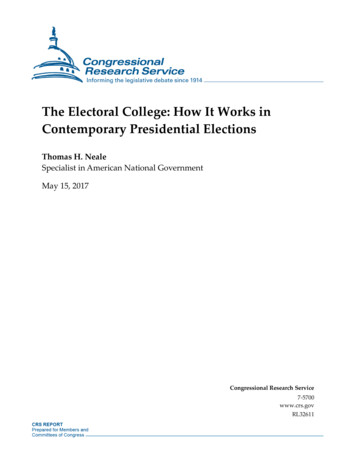
Transcription
The Electoral College: How It Works inContemporary Presidential ElectionsThomas H. NealeSpecialist in American National GovernmentMay 15, 2017Congressional Research Service7-5700www.crs.govRL32611
The Electoral College: How It Works in Contemporary Presidential ElectionsSummaryWhen Americans vote for a President and Vice President, they are actually choosing presidentialelectors, known collectively as the electoral college. It is these officials who choose the Presidentand Vice President of the United States. The complex elements comprising the electoral collegesystem are responsible for election of the President and Vice President.The 2016 presidential contest was noteworthy for the first simultaneous occurrence in presidentialelection history of four rarely occurring electoral college eventualities. These included (1) theelection of a President and Vice President who received fewer popular votes than their majoropponents; (2) the actions of seven “faithless electors,” who voted for candidates other than thoseto whom they were pledged; (3) the split allocation of electoral votes in Maine, which uses thedistrict system to allocate electors; and (4) objections to electoral votes at the joint session ofCongress to count the votes. These events are examined in detail in the body of this report.Article II, Section 1 of the Constitution, as modified in 1804 by the Twelfth Amendment, sets therequirements for election of the President and Vice President. It authorizes each state to appoint,by whatever means the legislature chooses, a number of electors equal to the combined total of itsSenate and House of Representatives delegations, for a contemporary total of 538, including 3electors for the District of Columbia. For over 150 years, the states have universally required thatelectors be chosen by the voters. Anyone may serve as an elector, except Members of Congressand persons holding offices of “Trust or Profit” under the Constitution.Every presidential election year, political parties and independent candidacies nominate theirnational candidates for President and Vice President. In each state where they are entitled to be onthe ballot, they also nominate a group (a “slate” or “ticket”) of candidates for the office of electorthat is equal in number to the electoral votes to which the state is entitled.On election day, Tuesday after the first Monday in November (November 3 in 2020), when voterscast a single vote for their preferred candidates, they are actually voting for the slate of electors intheir state pledged to those candidates. In 48 states and the District of Columbia, the entire slateof electors winning the most popular votes in the state is elected, a practice known as “winnertake-all” or “the general ticket” system. Maine and Nebraska use an alternative method, the“district system,” which awards two electors to the popular vote winners statewide, and one to thepopular vote winners in each congressional district.Electors assemble in their respective states on the Monday after the second Wednesday inDecember (December 14 in 2020). They are expected, but not constitutionally bound, to vote forthe candidates they represent. The electors cast separate ballots for President and Vice President,after which the electoral college ceases to exist until the next presidential election.State electoral vote results are reported to Congress and other designated authorities; they are thencounted and declared at a joint session of Congress held on January 6 of the year after theelection; Congress may, however, change this date by joint resolution. A majority of electoralvotes (currently 270 of 538) is required to win, but the results submitted by any state are open tochallenge at the joint session, as provided by law.Past proposals for change by constitutional amendment have included various reform options anddirect popular election, which would eliminate the electoral college system, but no substantiveaction on this issue has been taken in Congress for more than 20 years. At present, however, anon-governmental organization, the National Popular Vote (NPV) campaign, proposes to reformthe electoral college by action taken at the state level through an interstate compact; 10 states andthe District of Columbia have approved the NPV compact to date.Congressional Research Service
The Electoral College: How It Works in Contemporary Presidential ElectionsFor further information on contemporary proposals to reform or eliminate the electoral college,please consult CRS Report R43824, Electoral College Reform: Contemporary Issues forCongress, and CRS Report R43823, The National Popular Vote Initiative: Direct Election of thePresident by Interstate Compact.Congressional Research Service
The Electoral College: How It Works in Contemporary Presidential ElectionsContentsIntroduction . 1Most Recent Developments: The Electoral College and the 2016 Presidential Election . 1The Electoral and Popular Votes: Different Results . 1Faithless Electors . 2Maine Splits Its Electoral Vote . 2Unsuccessful Objection in the Joint Electoral Vote Count Session. 2Public Opinion and the Electoral College: Post-2016 Election Developments . 3Constitutional Origins . 3The Original Constitutional System . 4The Twelfth Amendment Repairs Flaws in the Original System . 5The Electoral College Today . 5Who Are the Electors? . 6Nominating Elector-Candidates: Diverse State Procedures . 6How Are Electoral Votes Allocated Among the States? . 7How Are the Electors Chosen?. 7The Electors’ Task: Ratifying the Voters’ Choice. 8Faithless Electors: Disregarding the Voters’ Choice . 82016: Faithless Electors—Ten Attempted, Seven Successful . 9General Election Ballots . 9The General Ticket and District Systems: How the States Award Their ElectoralVotes . 10The General Ticket System . 10The District System. 112016: The District System Produces a Divided Result in Maine . 12General Election Day . 12The Electors Convene and Vote . 13Congress Counts, Ascertains, and Declares the Vote . 13Objections to State Electoral Vote Returns . 142016: Attempted Objections in the Joint Session to Count Electoral Votes . 14A Tie or Failure to Win a Majority in the Electoral College: Contingent Election byCongress . 152020 Presidential Election: An Electoral College Timeline . 15Criticism and Defense of the Electoral College and Reform Proposals in Brief . 16Criticisms . 17Defense. 17Proposals for Change . 17Electoral College Reform . 17Direct Popular Election . 18Action in Congress on Electoral College Reform, 1940s-Present . 18Action at the State Level Since 2008 . 19NGO Proposal: The National Popular Vote Initiative . 20Concluding Observations . 21Congressional Research Service
The Electoral College: How It Works in Contemporary Presidential ElectionsFiguresFigure A-1. Map of State Electoral Vote Allocations, Presidential Elections of2012, 2016, and 2020 . 23TablesTable A-1. Electoral Vote Allocation by States and the District of Columbia, PresidentialElections of 2012, 2016, and 2020 . 24AppendixesAppendix. Electoral Vote Allocation by States and the District of Columbia . 23ContactsAuthor Contact Information . 24Congressional Research Service
The Electoral College: How It Works in Contemporary Presidential ElectionsIntroductionThe President and Vice President of the United States are chosen indirectly by a group of personselected by America’s voters. These officials are known as electors, and the institution is referredto collectively as the electoral college. Article II, Section 1 of the Constitution (1787), asmodified by the Twelfth Amendment (1804), provides the constitutional framework for theprocess, which, together with an array of subsequent federal and state laws and political partypractices, comprises the electoral college system as it exists today. It has been criticized by someas an undemocratic anachronism, but praised by others as a pillar of political stability andAmerican federalism.This report focuses on the institutions and procedures associated with the contemporary electoralcollege system. It opens by noting four rarely occurring electoral college eventualities that tookplace in connection with the 2016 presidential election. These included the election of a Presidentand Vice President who received fewer popular votes than their major opponents; the actions ofseven “faithless electors,” who voted for candidates other than those to whom they were pledged;the split allocation of electoral votes in Maine, which uses the district system to choose itselectors; and challenges to electoral votes in the joint session of Congress at which they arecounted.The report also examines the constitutional origins of the electoral college system and identifiesthe additional components and processes that are the product of federal and state law, partyrequirements, and political tradition, explaining their role in presidential elections. It provides atimeline for operation of the electoral college system for the 2020 presidential election, a briefexamination of alternative reform measures, including constitutional amendment proposals andnon-governmental initiatives, such as the National Popular Vote initiative1 (NPV), and closes withconcluding observations on the state of the electoral college system and prospects for change.Most Recent Developments: The Electoral Collegeand the 2016 Presidential ElectionThe 2016 presidential election will be recorded as the first in modern history in which fourelectoral college eventualities that have occurred separately in the past occurred during the sameelection cycle.The Electoral and Popular Votes: Different ResultsThe President and Vice President were elected with a majority of electoral votes, but fewerpopular votes than their major party opponents.2 The 2016 election marked the fourth occurrence1The National Popular Vote initiative is examined later in this report, under “Criticisms and Reform Proposals inBrief.” It is also the subject of CRS Report R43823, The National Popular Vote Initiative: Direct Election of thePresident by Interstate Compact, by Thomas H. Neale and Andrew Nolan.2Republican Party nominees Donald Trump and Mike Pence won 304 electoral votes, a majority of 56.5%, whileDemocratic Party nominees Hillary Clinton and Tim Kaine won 227 electoral votes, 42.2% of the total. Conversely,Clinton and Kaine won 65,853,516 popular votes, a plurality of 48.18% of the popular vote total, while Trump andPence won 62,984,825 popular votes, 46.09% of the total. Other candidates won seven electoral votes, 1.3% of theelectoral vote total, and 7,830,896 popular votes, 5.73% of the total. Source: U.S. Federal Election Commission,Official 2016 Presidential Election Results, January 30, 2017, at .pdf.Congressional Research Service1
The Electoral College: How It Works in Contemporary Presidential Electionsof this eventuality, which occurred previously in 1876, 1888, and 2000. This election result issometimes referred to, particularly by proponents of electoral college reform, as a “wrongwinner” election or an “electoral college misfire.”3 This eventuality stemmed directly from theconstitutional structure of the electoral college system. Article II, Section 1 of the Constitutionand its Twelfth Amendment require a majority of electoral votes to elect the President and VicePresident, but they contain no reference at all to popular votes.Faithless ElectorsSeven electors—five Democrats and two Republicans—cast votes for candidates other than thoseto whom they were pledged.4 This phenomenon, generally referred to as “faithless” or“unfaithful” electors, also derives directly from the Constitution, which in the TwelfthAmendment, instructs electors to “vote by ballot for President and Vice President.” Whiletradition that electors reflect the popular vote exerts a strong influence, there is no constitutionalrequirement that they vote for the candidates to whom they are pledged.Maine Splits Its Electoral VoteFor the first time since it adopted the “district system” to award electors, the electoral vote inMaine was split between the two major party tickets—Republican nominees Trump and Pencereceived one vote for the district they carried and Democratic nominees Clinton and Kainereceived three, one for the district they won and two at-large electors for winning the statewidepopular vote.5 This eventuality also has constitutional origins, since Article II, Section 1authorizes the states to appoint their electors “in such Manner as the legislature thereof maydirect.” The only other modern instance of the district system producing split electoral votesoccurred in Nebraska in 2008.6Unsuccessful Objection in the Joint Electoral Vote Count SessionTitle 3, Section 15 of the U.S. Code, which includes procedures for the counting of electoral votesin Congress, provides for objections to state certificates of electoral votes at the joint session ofCongress at which electoral votes are counted. Several Members of the House of Representativesraised objections to electoral votes at the January 6, 2017, joint session of Congress at which thevotes were counted. These objections were not considered, however, because they did not meetthe legal requirements, which include signatures from at least one Senator and oneRepresentative.73See, for instance, David W. Abbott and James P. Levine, Wrong Winner, The Coming Debacle in the ElectoralCollege (New York, Praeger, 1991), Neal R. Peirce and Lawrence D. Longley, The People’s President, The ElectoralCollege in American History and the Direct Vote Alternative, revised edition (New Haven, CT: Yale University Press,1980), “Chances of a Misfire,” pp. 116-119.4Federal Election Commission, Official 2016 Presidential Election Results, January 30, 2017, at .pdf.5Maine, Secretary of State, Tabulations for Elections Held in 2016, at html#tally.6At present, Maine and Nebraska are the only two states that award electoral votes by the district system. For furtherinformation, see in this report “The District System,” pp. 11-12.73 U.S.C. §15. For proceedings at the joint count session of January 6, 2017, please consult Congressional Record,daily edition, volume 163, number 4, pp. H185-H190.Congressional Research Service2
The Electoral College: How It Works in Contemporary Presidential ElectionsPublic Opinion and the Electoral College:Post-2016 Election DevelopmentsIn addition to these eventualities, the Gallup Organization measured a change in public supportfor the electoral college system—versus direct popular election—immediately following the 2016presidential election.Public opinion has consistently and historically favored direct popular election over retention ofthe electoral college, with support for direct popular election never previously falling below 58%,as measured by Gallup since 1967. In January 2013, for instance, the Gallup Poll reported that63% of respondents favored a constitutional amendment providing for direct popular election,while 29% favored retention of the electoral college.8Following the 2016 election, however, the Gallup Poll reported a rise in support levels for theelectoral college; according to poll results published on December 2, 2016, 49% of respondentsfavored an amendment providing for direct popular election, while 47% favored retention of theelectoral college.9 According to Gallup, this change was due to the fact that “[i]n the aftermath ofthis year’s election, the percentage of Republicans wanting to replace the Electoral College withthe popular vote has fallen significantly.”10 Specifically, support for direct election by respondentswho identified themselves as “Republican” or “Republican-leaning Independents” fell from 54%in 2012 to 19% following the 2016 election. Conversely, levels of support for direct popularelection among “Democratic or Democratic-leaning” respondents rose to new heights, from 69%in 2012 to 81% in 2016.11Constitutional OriginsThe Constitutional Convention of 1787 considered several methods of electing the President,including selection by Congress, by the governors of the states, by the state legislatures, by aspecial group of Members of Congress chosen by lot, and by direct popular election. None ofthese alternatives, however, proved satisfactory to the convention delegates. Late in theconvention, the matter was referred to the Committee of Eleven on Postponed Matters, whichdevised the electoral college system in its original form.12 This plan, which met with widespreadapproval by the delegates, was incorporated into the final document with only minor changes. Asdevised by the committee, the electoral college met several standards. It sought to reconcile and balance differing state and federal interests;give the state legislatures the authority to provide their preferred means ofchoosing the electors, including by popular vote, selection by the legislatureitself, or any other method;8Lydia Saad, “Americans Call for Term Limits, End to Electoral College,” The Gallup Poll, January 18, 2013, l-term-limits-end-electoral-college.aspx.9Art Swift, “Americans’ Support for Electoral College Rises Sharply,” The Gallup Poll, December 2, 2016, Ibid.12Although the term is not found in the Constitution, the electors have been known collectively as the electoral collegesince the early days of the republic, an expression that may be misleading, since the college has no continuingexistence, never meets in plenary session, and ceases to exist immediately after the electors have performed theirfunction.Congressional Research Service3
The Electoral College: How It Works in Contemporary Presidential Elections by providing the “constant two” “senatorial” or at-large electors, afford the“smaller” states some additional leverage, so the election process would not betotally dominated by the more populous states;preserve the presidency as independent of Congress for election and reelection;andgenerally insulate the election process from political manipulation.In the final analysis, the electoral college method of electing the President and Vice President wasperhaps the best deal the delegates felt they could get—seemingly the only one on which aconsensus could be formed—and one of many compromises that contributed to the convention’ssuccess. Alexander Hamilton expressed the delegates’ satisfaction with the electoral collegemethod, and perhaps reflected their relief at reaching an acceptable solution, when he wrote thisof the electoral college in The Federalist:The mode of appointment of the Chief Magistrate of the United States is almost the onlypart of the system, of any consequence, which has escaped without severe censure, orwhich has received the slightest mark of approbation from its opponents. I venturesomewhat further, and hesitate not to affirm that if the manner of it be not perfect, it is atleast excellent. It united in an eminent degree all the advantages the union of which wasto be wished for.13The Original Constitutional SystemThe Constitution gave each state a number of electors equal to the combined total of its Senateand House of Representatives membership.14 The electors were to be chosen by the states “insuch Manner as the Legislature thereof may direct” (Article II, Section 1). Qualifications for theoffice were broad: the only persons prohibited from serving as electors are Senators,Representatives, and persons “holding an Office of Trust or Profit under the United States.”15In order to forestall partisan intrigue and manipulation, each state’s electors were required toassemble separately in their respective states to cast their ballots rather than meet as a body in asingle location.16At least one of the candidates for whom the electors voted was required to be an inhabitant ofanother state. This was intended to counter what the framers feared would be a provincialinsularity once George Washington, the indispensable figure who was universally expected to bethe first President, had left the political scene. By requiring one of the candidates to be fromsomewhere else, the convention delegates hoped to prod the electors to look beyond the bordersof their own state or region in search of national candidates qualified and fit to serve as President.A number of votes equal to a majority of the whole number of electors was necessary to elect.This requirement was intended to insure that the winning candidate enjoyed broad support, whileelection by the House of Representatives was provided as a default method in the event ofelectoral college deadlock. Finally, Congress was empowered to set nationwide dates for choiceand meeting of electors.13Alexander Hamilton, “The Method of Electing the President,” in The Federalist, number 68 (Cambridge, MA:Belknap Press of Harvard U. Press, 1966), p. 440.14A map and table portraying the current allocation of electoral votes among the states may be found in the Appendixto this report, on pages 22-23.15U.S. Constitution, Article II, Section 1, clause 2.16Hamilton, “The Method of Electing the President,” p. 440.Congressional Research Service4
The Electoral College: How It Works in Contemporary Presidential ElectionsThe Twelfth Amendment Repairs Flaws in the Original SystemThe original method of electing the President and Vice President, however, proved unworkable.Under this system, each elector cast two votes for two different candidates for the office ofPresident, but no votes for Vice President. The candidate who received the most electoral voteswas elected, provided he received a number of votes equal to a majority of the whole number ofelectors—not a majority of electoral votes. Nobody actually ran for Vice President—the runnerup in the presidential contest was elected to the second office. This system, which was intended tobring the two best qualified candidates to office, never anticipated the early growth of politicalparties and factions, each of which offered a joint ticket of two candidates—one for President andone for Vice President.By the third election, in 1796, the nascent political parties of the day, Federalists and antiFederalists (also known as Jeffersonians or Republicans),17 each offered a joint ticket. Under theoriginal arrangement, the only way to make the system work was for all of the party’s electors tocast one of their two votes for the recognized presidential candidate, and all but one of theelectors cast their second votes for the vice presidential candidate. One elector would beinstructed to withhold his second vote for the designated vice presidential candidate, so that thetwo candidates would not tie the vote and throw the election to the House.This cumbersome system broke down almost immediately, in 1800, when a Republican electorfailed to withhold his second vote from the acknowledged vice presidential candidate. This led toa tie between presidential candidate Thomas Jefferson and his running mate, Aaron Burr, leavingthe election to be decided in the House of Representatives. The constitutional crisis resulting fromthe election of 1800 led to the Twelfth Amendment, which was proposed by Congress andspeedily ratified by the states, as noted later in this report.18The Electoral College Today19Notwithstanding the founders’ efforts, the electoral college system almost never functioned asthey intended, but, as with so many constitutional provisions, the document prescribed only thesystem’s basic elements, leaving ample room for development. As the republic evolved, so did theelectoral college system; by the late 19th century the following range of constitutionalrequirements, federal and state legal provisions, and political party practices that make up thecontemporary system were in place.17To avoid confusion, it should be noted that the “Jeffersonian” or “Republican” proto-party of the 1790s was theancestor of the modern Democratic Party. The modern Republican Party, which also claimed descent from theJeffersonians, emerged in the 1850s.18For further information on the election of 1800 and the Twelfth Amendment, see Peirce and Longley, The People’sPresident, revised edition, pp. 36-44.19For information on electoral college reform, please consult CRS Report R43824, Electoral College Reform:Contemporary Issues for Congress, by Thomas H. Neale, and CRS Report R43823, The National Popular VoteInitiative: Direct Election of the President by Interstate Compact, by Thomas H. Neale and Andrew Nolan.Congressional Research Service5
The Electoral College: How It Works in Contemporary Presidential ElectionsWho Are the Electors?20The Constitution, as noted earlier in this report, states what the electors may not be; that is, itprohibits Senators, Representatives, and persons holding an “Office of Trust or Profit under theUnited States” from serving. In effect, this language bars not only Members of the two houses ofCongress, but any person who is an employee of the United States government: Justices, judges,and staff of the U.S. courts and the federal judiciary; all political employees of the legislative andexecutive branches; civilian employees of the U.S. Government, that is, “civil servants,” and U.S.military and law enforcement personnel.21In practice, the two major political parties in each state tend to nominate a mixture of well-knownfigures such as governors and other state and local elected officials, party activists, local and statecelebrities, and “ordinary” citizens for the office of elector.While they may be well-known persons in their states, electors generally receive little recognitionas such. In most states, the names of individual elector-candidates do not appear anywhere on theballot; instead only those of the presidential and vice presidential candidates of the parties orother groups that nominated the elector-candidates appear. In some states, the presidential andvice-presidential nominees’ names are preceded on the ballot by the words “electors for.” Theusual anonymity of presidential electors is such that electoral votes are commonly referred to ashaving “been awarded” to the winning candidates, as if no human beings
opponents; (2) the actions of seven "faithless electors," who voted for candidates other than those to whom they were pledged; (3) the split allocation of electoral votes in Maine, which uses the . votes (currently 270 of 538) is required to win, but the results submitted by any state are open to challenge at the joint session, as .



